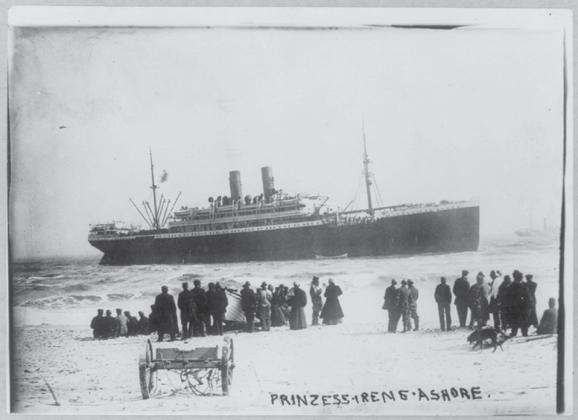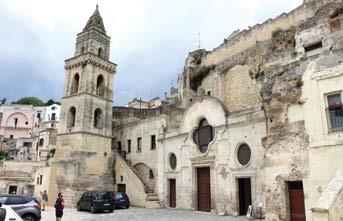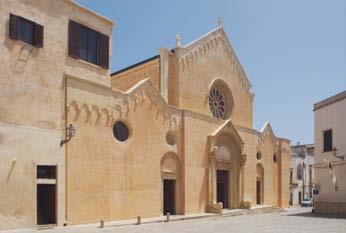
12 minute read
Our Story
Italians Lynched in Tallulah Are Honored with Historical Marker at Gravesite
On a July night in Tallulah, Louisiana, Dr. J. Ford Hodge shot and killed a goat that had wandered into his garden. The following day—July 20, 1899—Pasquale Di Fatta approached Hodge about having killed his goat. Hodge knocked Pasquale to the ground and began striking him with the gun in his hand. He pointed the muzzle at Pasquale’s head and pulled the trigger.
Advertisement
But the gun jammed.
Meanwhile, Pasquale’s brother, Giuseppe, ran out of the family’s local grocery, shotgun in hand. He aimed and fired at Hodge. The birdshot pellets from the shotgun hit Hodge in the abdomen and thighs, causing only minor injuries. In spite of this, rumor quickly spread through town that Hodge had been murdered. A mob formed and hunted down the Di Fatta brothers. One bar owner even offered free drinks to anyone who took part in killing the brothers. The mob lynched both Pasquale and Giuseppe in a slaughter yard. Then the mob turned its attention to their younger brother Francesco, cousin Rosario Fiduccia, and brother-in-law Giovanni Cirami, putting their heads through nooses as well. According to one witness, Francesco said, “I live here six years. I know you all. You all my friends.” Then the rope was pulled.
After all five men died, the mob then shot at their bodies until they were no longer recognizable. Meanwhile, part of the mob pursued three other family members living in the nearby town of Milliken’s Bend. However, the men were able to escape by boat across the Mississippi River to Vicksburg, Mississippi.
Following the lynching, no arrests were made.
The Italian Society of Vicksburg and the Italian Counsel Agent, Natale Piazza, believed that the victims should not be buried in the soil on which they were murdered. They instead arranged to have them interred at Cedar Hill Cemetery in Vicksburg—a little more than 20 miles from Tallulah—on July 28, 1899. One hundred and twenty-two years later—on Friday, March 19, 2021—the State of Mississippi and City of Vicksburg recognized the five Italian men with a Mississippi State Historical Marker that was dedicated at their burial site. The historical marker was sponsored by three descendants of Giuseppe Di Fatta—Antoinette Fatta Helton, Deborah Helton Flores, and Linda Fatta Ott—to ensure that the men will never be forgotten. Father Rusty Vincent of St. Paul’s Catholic Church in Vicksburg blessed the burial site. Linda Fatta Ott officiated the ceremony and remarked how her grandfather, Nicolo Di Fatta (Nick Fatta), anguished over the fact that his father, Giuseppe, never received a proper Catholic burial. Having passed away in 1967, Nick can now finally rest in peace as well. “Nick would be very proud of this ceremony and what the marker represents,” Linda said. More than 60 people gathered at the gravesite to honor the five Italian men. This included their descendents, Vicksburg Mayor George Flaggs, Jr., Pasquale Di Fatta Tallulah Mayor Charles Finlayson, fellow Italian Americans, historians,
and friends. Cynthia Savaglio, Meanwhile, today’s public ofa University of Tampa Assistant ficials have done what they can to professor who wrote a screenplay observe the wrongs of the past. about the Tallulah lynching, pre- Governor Tate Reeves of Missented on the events surrounding sissippi recently wrote a letter to the murders. After the lynching, Giuseppe Di Fatta’s family regardshe stated, American newspapers ing the monument for Pasquale, and magazines reported incor- Giuseppe, Francesco, Rosario, and rect information in an attempt to Giovanni. In it, he stated, “This justify the actions of the lynchers. state historical marker will ensure
All five of the Italian men had that Mississippians will remember immigrated to Louisiana from their names so that we will never Cefalù, Sicily, in hope of mak- repeat the tragedy of the past.” ing a better life for their families. The Mayor of Cefalù, Rosario Their lynching triggered another Lapunzina, also wrote to the faminternational incident eight years ily. He stated: after to the tragic lynching of 11 Italian men that occurred in New Orleans in 1891. The fact that “In today’s world, there are too none of those who performed the lynching was ever charged created many signs that the terrible history of the nineteenth and twentieth centuries can be tension with Italy. While Presi- repeated, and that racism, dent William McKinley vowed to prejudice, and human stupidity make the crime a priority and bring those responsible to are now a daily occurrence. For this reason, each justice, that never transpired. In his December 1899 State of us has the duty to educate young people in the of the Union Address, he stated in part: values of solidarity, acceptance, and respect.”
Brothers, Giuseppe (left) and Franceso Di Fatta.

For the fourth time in the present decade, question has arisen with the Government of Italy in regard to the lynching of Italian subjects. The latest of these deplorable events occurred at Tallulah, Louisiana, whereby five unfortunates of Italian origin were taken from jail and hanged.
(translated from Italian to English)
The victims’ families believe this historical marker will serve as an acknowledgment of the wrongs that occurred 122 years ago and a step forward to healing.
“Certainly the five Italians shall never be forgotten,” Linda Fatta Ott said.
OSIA members benefit from a 10% discount on all our services!
Do You Ever Imagine Your Italian Ancestors?
Bring that vision to life with real history.

• Discover centuries of information about your roots through our research services onsite in Italy • Obtain your Italian Dual Citizenship by working with us to manage the application process.
For more information, visit www.myitalianfamily.com, or call 1-888-472-0171

BY KRISTIN D’AGOSTINO
At 26 years old, having finished a five-month stint working as a nanny in Salerno, I celebrated my newfound freedom by renting a Fiat with a friend and heading south. The rocky Amalfi Coast’s bustling port towns gave way to verdant hills dotted with olive trees and farmhouses. My companion, a cheerful New Zealander named Arianna, was also a nanny whom I’d met just a few weeks earlier when we were both flirting with the same Italian guy at the local tourism office. No romance came out of our efforts, but a muchneeded friendship formed. Finally, after a long summer of raucous family dinners where my Italian vocabulary ran out before the pasta was served, I had found an English-speaking friend to share the joys and challenges of navigating Italian culture.
Our first stop was Alberobello, a UNESCO site known for its 14th century limestone houses—or trulli—whose conical rooftops resemble mushrooms. Thousands of trulli filled the narrow streets, forming a whitewashed wonderland, each one bearing its own rooftop symbol painted in white on the gray stones. Suns, hearts, and moons decorated the rooftops. What did they mean? During my brief visit, I never learned.
Arianna and I rented a trullo for the night—the perfect cozy setting for sharing stories. Red wine flowed along with tales of failed romances and pointed remarks on Italian families. “Why do they call it a matrimonia bed anyway?” I asked, plopping down on one of the full-sized beds. “It’s not just for couples. In the house where I lived the entire family slept together every night. Two parents, one cat, and three kids!”
Late into the night our laughter filled the one-roomed chamber, echoing off the round stone ceiling. For the first time in five months, I felt warm, connected, and at home.
Now, nearly two decades later and cooped up during the pandemic, my memories of this road trip spark wanderlust. What would a road trip through the south be like these days? What other architectural wonders lay waiting to be discovered? To shed light on my wonderings, I consulted Art and Architecture Professor Rocky Ruggiero and Puglia-based tour guide Emanuela D’Andria.

THE CAVE CHURCHES OF MATERA
The south is unique, D’Andria says, because it forms a crossway between East and West. Many cultures have dominated this area through the centuries—Greeks, Romans, Byzantines, Normans, Ottomans, Germans, and Spanish. All have left their mark on the south’s art, culture, and traditions. No visit to the Deep South would be complete without a visit to Matera, situated in the Basilicata region on the instep of the boot’s heel. Narrow streets climb up to this otherworldly city built on a hill, its houses formed within ancient caves. Matera’s resemblance to Jerusalem has earned it a place in many Biblical films

San Pietro Caveoso (left) and Santa Maria De Idris (top right) are some of the ancient cave churches that can be seen in Matera. (Massimo Todaro)
(Sailko)

San Pietro Barisano, the largest of Matera’s ancient cave churches.
throughout the years. The city’s cave dwellings, or sassi, date back to the Paleolithic period more than 2.5 million years ago. Despite unseemly living conditions, up to 12 family members lived together in one room. The sassi were inhabited up until the 1950s, when the government stepped in and forced people to leave their homes and move into a newly constructed neighborhood. In later decades, the sassi received a facelift, and now most of its 3,000 caves serve as home for the city’s inhabitants while many others function as restaurants and hotels. Lovers of antiquity will no doubt enjoy simply wandering the city’s many serpentine alleys and climbing its winding staircases. But to get the full experience, one must duck inside one of many cave churches. With their shadowy stone chambers rich in frescoes, they are a mix of haunting and holy, beautiful and beatific. The largest of them, San Pietro Barisano, dates back to the 12th century and is particularly spooky as its altar was plundered in the 1970s and the surrounding statues were rendered headless. Visitors are greeted at the church entrance by frescoes of the Annunciation and the saints. Exploring the underground area where a labyrinth of stone niches forms an ancient catacomb, one can say they’ve truly experienced Matera—the Citta Sotterranea, or Underground City.
FREDERICK II’S CASTLE
The Puglia region’s culture and architecture have been greatly shaped by Holy Roman Emperor Frederick II. Though he had German and Norman blood, Frederick II lived in Bari for many years and considered Italy, particularly Puglia, his home. During his time as emperor, he transformed Puglia’s landscape by having numerous castles constructed throughout. By far, the most magnificent of these is Castel del Monte, located northwest of Bari.
Frederick II, besides being a skilled hunter and passionate traveler, was a great lover of art and science.
“He was an enlightened man,” says Art and Architecture Professor Rocky Ruggiero. “The fact that he settled in Bari meant that artists and musicians came there. There was a 13th-century flowering in that area because of the presence of the imperial court.”
Castel del Monte, which is pictured on Italy’s one-cent Euro coin, is unique because it combines diverse styles of architecture, mixing Islamic and Classical with North-European Cistercian Gothic. The majestic building is a testimony to Frederick’s fascination with astronomy and science. Shaped like an octagonal prism, the castle is located in a carefully chosen manner to invite symmetries of light during the winter and summer solstice. Frederick’s love of numbers is also evident, as both of the castle’s floors contain eight rooms and an eight-sided courtyard forms the heart of the castle.
No one knows exactly why Frederick constructed Castel del Monte. It has no moat, no arrow slits, and no drawbridge—it was not built to serve as a fortress. With its octagonal union of a square inside a circle, some speculate it was built to be a celebration of the interconnecting relationship between humanity and God.
Castel del Monte, Frederick II’s medieval fortress. (Stefano_Valeri)
LECCE AND THE FRESCOES OF BASILICA DI SANTA CATERINA D’ALESSANDRIA
Southern Italy may not contain Tuscany’s Renaissance treasures, but it boasts its own version of Florence and a cathedral that rivals Florence’s finest frescoed churches. The city of Lecce has been called “The Florence of the South” with its baroque old town adorned with noble palaces, charming squares, baroque churches, and Roman monuments.

The Basilica di Santa Caterina d’Alessandria. (Gherzak)
The Basilica di Santa Caterina d’Alessandria in Galatina, a town south of Lecce, has an array of vibrant 14th-century frescoes. The church was built by the Franciscans, whose patron was Frenchwoman Marie d’Enghien de Brienne. De Brienne was married to Raimondello Orsini del Balzo, a wealthy noble who traveled to Mount Sinai to visit the relics of Santa Caterina. After kissing the dead saint’s hand, he bit off a finger and brought it back to the basilica as a holy relic. Though the finger has since disappeared from the basilica, del Balzo remains—as it is where he’s buried.
The cathedral exhibits a mix of Romanesque, Gothic, Norman, and Byzantine architecture. Its interior is entirely covered in frescoes painted by Neapolitan artists, which are said to rival Giotto’s frescoes in the Basilica di San Francesco d’Assisi. One of the most unique frescoes depicts angel musicians holding an array of medieval instruments—the oldest recorded depiction of harps, double flutes, and lutes in Europe.

The frescoes inside the Basilica di Santa Caterina d’Alessandria.
Kristin D’Agostino is a journalist and poet based in Vermont. She writes stories about Italian culture and teaches Viva Italia! memoir-writing workshops that offer Italian Americans the chance to embrace their roots through writing. Connect with her at www.kristinmdagostino.com.
THE TRULLI OF ALBEROBELLO
But what about Alberobello’s mystical dwellings and their strange symbols? According to Ruggiero, the houses began as small agricultural constructions built by shepherds tending their flocks in the fields. Constructed by placing rock over rock, the improvised huts protected them from the blazing southern sun.
“Later,” D’Andria continues, “the town’s peasants adopted the trullo’s construction when the King of Naples imposed a tax on new constructions.”
“It was then necessary to build something temporary, easy to dismantle, that could not be considered a regular permanent home,” D’Andria points out. The townsfolk adapted the shepherds’ trullo to their needs, the weather and everyday life. Being superstitious, the homeowners added symbols on the conical rooftops to protect them from the evil eye and bad luck.
“The symbols can be very different,” D’Andria says. “A cross, a dove, a sun, moon, star, menorah, a letter, a tree, but they all have the same aim: to protect the trullo and its inhabitants.”
Architecture aside, the regions of Puglia and Basilicata offer many gastronomical treasures for foodies and wine lovers. Ruggiero, who lived in Tuscany for 20 years, said he prefers to buy his olive oil from Puglia. In Tuscany, olive trees are trimmed to a smaller size yielding a more refined taste, whereas in Puglia they’re allowed to grow wild resulting in a fruitier, spicier flavor. Dotting the southern landscape, the olive trees are architectural gems all their own.
“Giant, gnarly, centuries old … they’re like works of art,” Ruggiero says. “The form they take is breathtaking.”








